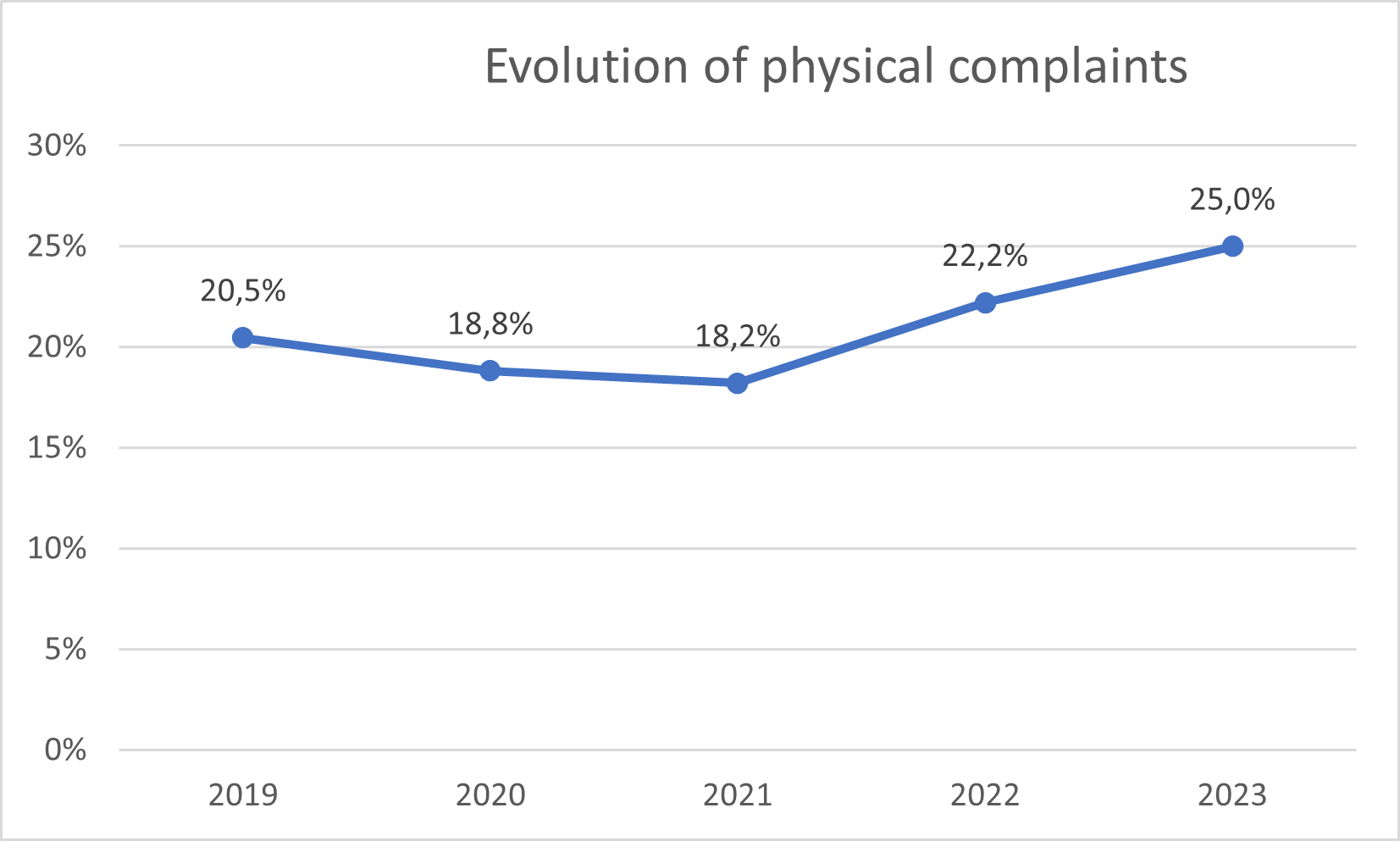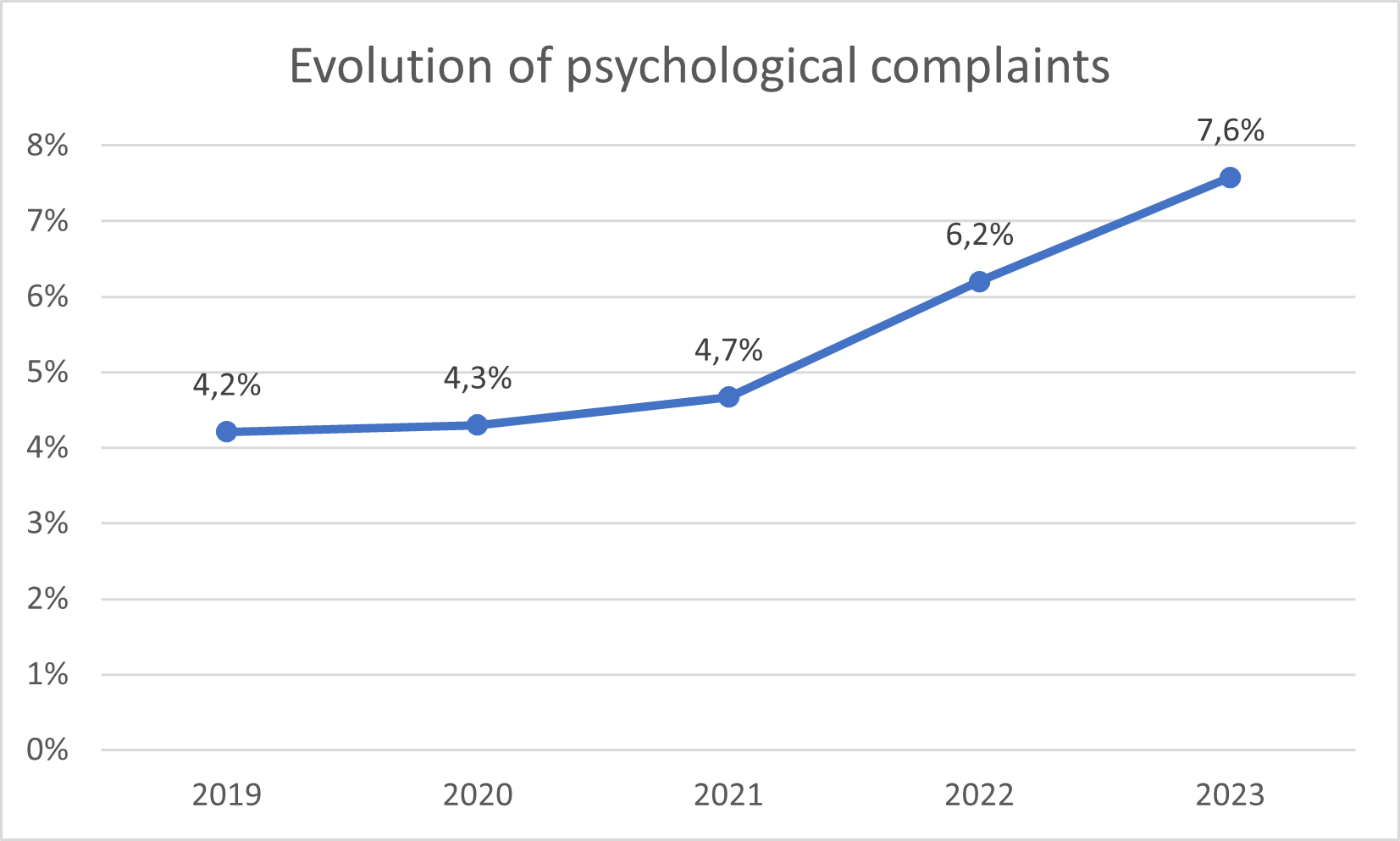Physical and psychological complaints rise sharply among workers
The number of workers across the nation with motor or mental health complaints has risen sharply over the past five years. A quarter of working Belgians experience discomfort while moving, 7.5% have mental health complaints, either separately or alongside physical issues. Both in the service sector and in education, the number of people with complaints is increasing at a rapid rate, according to an analysis of the data from over 320,000 working Belgians.
The study in a nutshell:
- A quarter of employees report having motor complaints, such as pain in shoulders, neck or (lower) back. That is 22% more compared with five years ago.
- Some 7.5% of employees also report psychological complaints. That is a whopping 80% increase compared with five years ago.
- Workers in construction are most often reporting physical complaints, but the increase over the past five years has been greatest in education (+64%), services (+40%) and healthcare (+36%).
- In the public sector, employees most often report mental health complaints, but the increase over the past five years has been greatest in education (+153%).

Physical and mental well-being: never before has there been so much emphasis on these factors in the workplace. Organisations are taking all kinds of initiatives to keep employees healthier and more energetic at work, such as adapted work organisation, support through training and coaching or setting up ergonomic workplaces.
These efforts are often a good first step, but the study shows that they are not yet always translating into the numbers. Indeed, more and more working Belgians are struggling with a variety of complaints, most of which can be linked to the work they do.
An initial remarkable finding: as many as a quarter of workers have motor complaints. These are disorders of muscles and joints, such as pain in the neck, shoulders or (lower) back. The number of workers with motor complaints has increased by about 22% over the past five years. The last two years in particular have seen notable increases. Lower back pain (19.3%), osteoarthritis of the spine (6.7%) and shoulder pain (5.1%) are the most common physical problems.
Motor complaints spike among display screen workers
For a long time, we only associated physical complaints with more physically intense occupations. Primarily in construction (30.5%), food (29%) and chemicals (27%), the percentage of workers with motor complaints is remaining the highest. The largest increase in this category can be seen in healthcare (+36%).
But over the last two years, we are also noting a sharp increase among the working population who spend multiple hours per day in front of a screen (the display screen workers), most of whom work in the service sector. The number of service sector workers with such complaints has increased by 40 per cent over the past five years.
And the increase in education is also very significant in recent years (+64% over five years), although the percentages there are still clearly lower than in the other sectors.

Some of the increase in physical complaints is directly due to the work itself. On the one hand, workers in physically demanding occupations, such as in construction, continue to work until later in life and the workload is higher, making them more likely to develop motor complaints. On the other hand, frequent screen work - at home or in the office - has been causingmore neck, back and shoulder problems in recent years.
Focusing on ergonomics both prevents and reduces physical complaints and has a positive impact on employees' productivity, mood and general well-being. This involves providing ergonomic equipment, but equally includes teaching and encouraging healthy behaviour, such as alternating between sitting and standing and postural variation.
- Dorien Simons, wellness expert at Mensura
| Industry | 2019 | 2020 | 2021 | 2022 | 2023 | Increase 2019 - 2023 |
| Construction | 27.4% | 26.7% | 25.6% | 27.7% | 30.5% | +11% |
| Services | 17.0% | 16.4% | 15.7% | 19.4% | 23.8% | +40% |
| Logistics | 20.7% | 19.7% | 17.3% | 23.2% | 24.8% | +20% |
| Education | 7.2% | 6.9% | 7.5% | 10.0% | 11.8% | +64% |
| Public sector | 15.2% | 19.5% | 16.0% | 21.2% | 22.7% | +49% |
| Food | 22.3% | 22.4% | 22.7% | 23.2% | 29.0% | +30% |
| Healthcare | 17.9% | 11.2% | 15.6% | 21.0% | 24.3% | +36% |
Table: Percentage of workers with physical complaints by sector by year,
including increase over the last five years.
Number of employees with mental health problems on the rise
Besides the number of motor complaints, the number of workers suffering from mental discomfort has also increased over the past five years. And this is quite hefty: five years ago, 4.2% of workers reported suffering from mental health problems, by 2023 it was 7.5%. That is a whopping 80% increase. The number of workers with mental health complaints rose sharply especially after the Covid-19 crisis.

Rates are highest in the public sector (9.7%), healthcare and services (both 8.9%). The sharpest increase over the past five years can be seen in education (in which 7.3% report mental health complaints) and the public sector (in which 9.7% report having mental health complaints). In each of those sectors, we record more than a doubling. Logistics (7.4%) and services (8.9%) also saw almost a doubling in the last five years.
The increase in the number of employees with mental health complaints is a direct consequence of the fact that the workload is increasing, partly because everyone is accessible everywhere they are, but also because life as a whole is becoming more complex and hectic. Working more and more online puts extra strain on the brain, making it harder to break down stress hormones.
Employers are increasingly aware of the importance of mental and physical well-being, and they also realise that indicators such as conflict, stress complaints, etc. are important signals to offer employees more support in terms of well-being.
We recommend that employers devise a preventive welfare policy that suits their needs by first identifying their psychosocial risks. Once that is done, we can establish targeted actions for certain topics, departments, target groups and so on. These include workshops on unplugging, training programmes for managers to discuss mental issues or strengthen resilience, and stress training sessions for employees facing their limits or reintegration after long-term absences.
- Julie Daenen, well-being expert at Mensura
| Industry | 2019 | 2020 | 2021 | 2022 | 2023 | Increase 2019 - 2023 |
| Construction | 3.6% | 3.1% | 3.0% | 3.9% | 5.0% | +39% |
| Services | 4.6% | 5.0% | 5.0% | 6.6% | 8.9% | +93.5% |
| Logistics | 3.7% | 4.0% | 4.8% | 5.9% | 7.4% | +99.5% |
| Education | 2.9% | 2.9% | 3.7% | 4.6% | 7.3% | +153% |
| Public sector | 4.5% | 5.6% | 5.5% | 8.4% | 9.7% | +115.5% |
| Food | 3.7% | 4.7% | 4.8% | 4.5% | 6.1% | +65% |
| Healthcare | 5.1% | 3.8% | 5.7% | 7.7% | 8.9% | +74.5% |
Table: Percentage of workers with psychosocial complaints by sector by year,
including increase over last five years.
Healthy hybrid working: a shared responsibility
There has been a sharp increase in mental health complaints, especially after the corona crisis. This is partly explained by the fact that working from home creates new challenges for employees. Balancing work and private life isn’t easy for everyone, given the blurring boundaries between the two.“There is no ‘one size fits all’ solution because everyone has different needs. The main difference can be made between integrators, who like to combine work and private life, and segmentors, who prefer to keep them separate,” Julie Daenen clarifies.
Mensura sees this as a shared responsibility and particularly encourages employers to raise awareness about the importance of disconnecting. It is also important to create more space for dialogue on employees’ needs in this area. Mensura can help with tailored advice on deconnection, stress management and leadership.